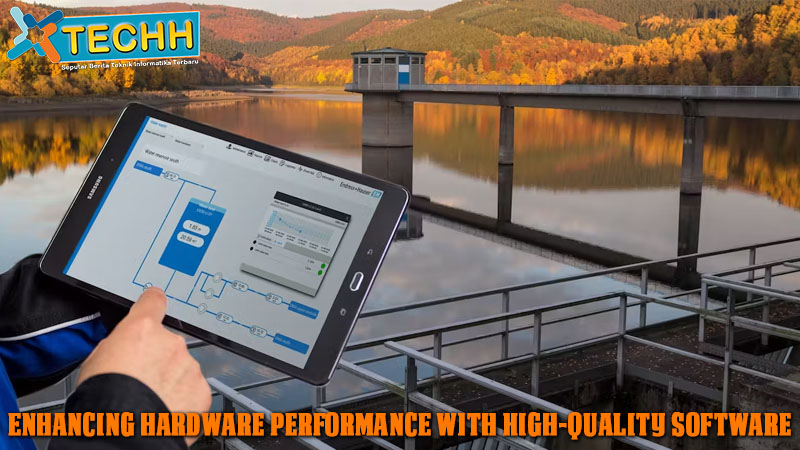Introduction
Enhancing Hardware Performance In today’s rapidly evolving technological landscape, the pursuit of high-performance computing is a relentless endeavor. Companies and individuals alike are constantly seeking ways to improve the efficiency and capabilities of their hardware systems. While hardware advancements are crucial, equally important is the role that high-quality software plays in harnessing the full potential of these systems. This article delves into the profound impact of high-quality software on hardware performance enhancement, exploring various aspects such as optimization techniques, parallel computing, and the symbiotic relationship between hardware and software.
I. The Significance of Software in Hardware Performance
1.1. Software’s Role in Utilizing Hardware Resources
Hardware, on its own, is like a blank canvas waiting for an artist’s touch. Without the appropriate software, even the most powerful hardware remains underutilized. High-quality software is the key to unlocking the full potential of modern hardware, as it determines how efficiently resources are managed and tasks are executed.
1.2. Software as a Bridge to Innovation
As hardware continues to evolve at a breakneck pace, software must keep pace to fully leverage these advancements. Software innovation enables existing hardware to perform tasks that were previously unimaginable, extending the lifespan and utility of technology investments.
II. Optimization Techniques
2.1. Compiler Optimizations
Compiler optimizations are one of the first lines of defense in enhancing hardware performance through software. Compilers translate human-readable code into machine code, and the quality of this translation can significantly impact performance. Advanced compilers employ various optimization techniques, such as loop unrolling, instruction scheduling, and vectorization, to generate highly efficient machine code.
2.2. Profiling and Performance Analysis
Profiling tools allow software developers to identify bottlenecks and resource-hungry sections of code. By analyzing the performance data collected during profiling, developers can pinpoint areas for improvement and optimize code accordingly. Profiling helps in achieving better resource allocation and, ultimately, enhanced hardware performance.
2.3. Just-In-Time Compilation (JIT)
JIT compilation is a technique used in virtual machines and interpreters to improve the execution speed of programs. It compiles code at runtime, optimizing it for the specific hardware it’s running on. This on-the-fly compilation allows software to adapt to different hardware configurations, ensuring optimal performance across a variety of systems.
III. Parallel Computing
3.1. Multi-Threading
Modern CPUs often come equipped with multiple cores, each capable of executing tasks independently. High-quality software takes advantage of multi-threading, distributing tasks across these cores to perform computations concurrently. This parallel execution can lead to significant speedups in tasks that can be divided into smaller, independent subtasks.
3.2. GPU Acceleration
Graphics Processing Units (GPUs) have evolved beyond their original purpose of rendering graphics. They are now powerful parallel processors suitable for a wide range of computationally intensive tasks. High-quality software leverages GPU acceleration, offloading certain calculations from the CPU to the GPU for faster execution.
3.3. Distributed Computing
For tasks that require even more computing power, distributed computing can be employed. Software can be designed to run on clusters of machines, with each node contributing its processing power to the task at hand. This approach is commonly used in scientific research, data analysis, and large-scale simulations.
IV. Hardware-Software Co-Design
4.1. Tight Integration
To achieve the highest levels of hardware performance, it is essential to consider hardware and software design together. Hardware-software co-design involves developing both components in tandem, ensuring that they are tightly integrated and optimized for each other. This approach can result in significant efficiency gains and performance improvements.
V. Machine Learning and Artificial Intelligence
5.1. Neural Network Optimization
The field of machine learning and artificial intelligence heavily relies on high-quality software for optimizing neural networks. Techniques such as quantization, pruning, and model distillation help reduce the computational requirements of deep learning models, making them more hardware-efficient.
5.2. Hardware Accelerators
Hardware accelerators, such as TPUs (Tensor Processing Units) and NPUs (Neural Processing Units). Are specifically designed to accelerate machine learning workloads. High-quality software frameworks, like TensorFlow and PyTorch, enable seamless integration with these hardware accelerators, leading to faster training and inference times.
VI. Real-World Examples
6.1. Gaming Industry
The gaming industry is a prime example of how high-quality software can enhance hardware performance. Game engines are meticulously optimized to make the most of available hardware. Delivering stunning graphics and smooth gameplay. Techniques like level-of-detail rendering, real-time ray tracing, and dynamic resolution scaling adapt to the capabilities of the player’s hardware, ensuring a satisfying gaming experience.
6.2. Cloud Computing
In the realm of cloud computing, providers like Amazon Web Services (AWS) and Microsoft Azure offer a vast array of hardware configurations. High-quality software, such as container orchestration platforms like Kubernetes, efficiently manages the allocation of virtual resources, ensuring that applications run seamlessly across diverse hardware environments.
VII. Challenges and Considerations
7.1. Software Complexity
While high-quality software can significantly enhance hardware performance, it also comes with its own set of challenges. Complex software systems can be harder to optimize and maintain, requiring skilled developers and rigorous testing processes.
7.2. Compatibility
Ensuring compatibility between software and hardware is crucial. Incompatibilities can lead to reduced performance or system instability. Careful consideration must be given to hardware requirements when designing and deploying software.
7.3. Maintenance
High-quality software requires ongoing maintenance and updates to remain optimized for evolving hardware platforms. Neglecting software updates can lead to performance degradation and security vulnerabilities.
VIII. Conclusion
The quest for high-performance hardware is an enduring pursuit, but it’s incomplete without the parallel pursuit of high-quality software. The symbiotic relationship between hardware and software is at the heart of technological advancement. As hardware continues to advance, it is the responsibility of software developers to harness this potential fully. Through optimization techniques, parallel computing, hardware-software co-design, and innovations in machine learning, high-quality software remains the linchpin in enhancing hardware performance. As technology continues to evolve, it is the harmonious convergence of hardware and software that will drive the future of computing.
Di dunia di mana kinerja menjadi lebih penting dari sebelumnya, perangkat lunak berkualitas tinggi adalah jembatan untuk mengungkap kekuatan sesungguhnya dari perangkat keras kita, mendorong batas-batas dari apa yang mungkin terjadi di bidang teknologi.





